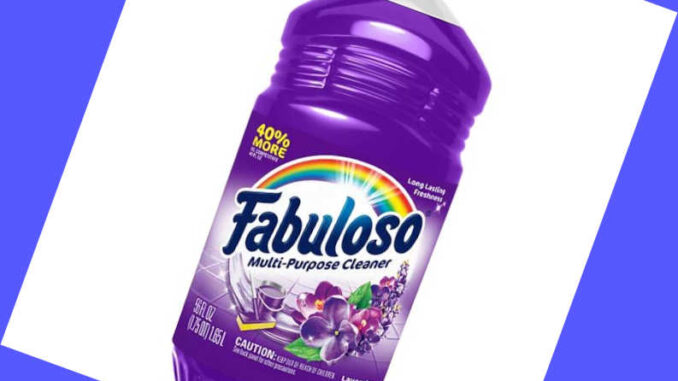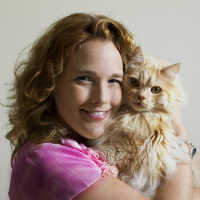
This article was updated on January 15th, 2024
As pet owners, we want to ensure we are using the safest products on our pets and in our everyday cleaning products. Sometimes finding these products or knowing which are harmful can be overwhelming.
When used appropriately, Fabuloso is safe for dogs
When used appropriately, Fabuloso is safe for dogs and other pets – but to an extent:
- If your pet walks in after you have finished mopping, you probably don’t need to worry.
- It probably isn’t a big deal if your pup licks the floor once or twice,
- It is generally ok if your pup is in the room and breathes the air after using the cleaner
However, Fabuloso is dangerous and problems can arise if:
- Your dog starts drinking the cleaner from a bucket
- Your dog ingests the cleaner or breathes in high amounts of certain chemicals like bleach.
Do not use Fabuloso to bathe or clean your dog
Don’t use Fabuloso to bathe your dog. The product contains chemicals that can irritate the skin. Even certain fragrances can cause skin irritation.

If you want to wash your dog, it’s best to use a dog shampoo specifically made for pets. These companies ensure the products contain safe components for your pet and their skin.
Oatmeal-based dog shampoos are great all-purpose shampoos to try instead. They are often gentle and soothing to the skin. If your dog has skin concerns or open wounds, it is best to consult your veterinarian about the most appropriate products.
What are the signs that Fabulogo is hurting my dog?
If your dog is showing these symptoms, it would be best to contact your veterinarian for their advice:
§ Nausea, vomiting, lip-smacking
§ Diarrhea
§ Other signs of discomfort and illness
However, there may be a few things you can do at home to help until you can get to a vet clinic or speak to your vet.
What are the symptoms of my dog swallowing Fabuloso?
A dog swallowing something potentially harmful is many pet owners’ worst nightmare. We want to protect our dogs as best as we – after all, they are family!
Skin and eyes
Multi-purpose cleaners typically do not cause severe skin irritation, but it is best to wash any areas your dog may have come in contact with the product. These products can also cause eye irritation if directly splashed in the eyes. In those cases, it is best to rinse the eyes immediately with a non-medicated sterile eye rinse and get to your vet’s office.
Ingestion
With cleaning products, the most serious exposure is often swallowing the toxin. This allows the chemicals direct access to the intestinal tract, causing mild gastrointestinal irritation.
Some toxins cause a reaction immediately, but some can cause symptoms several hours later. If your pet ingested a large amount, the symptoms might be more severe.
FAQ about dog’s exposure to Fabuloso
What do I do if my dog ingests something potentially harmful?
If you suspect your dog has eaten something toxic, you may wonder what to do.
1. Keep them from eating or ingesting more. Either remove your pet from the area or clean up the chemical immediately.
2. Contact your vet for immediate advice. If you cannot reach your vet’s office, call one of the pet poison helplines or ASPCA poison control for further advice.
3. Follow any information on the package, if applicable, regarding exposure.
Key tip from a veterinarian: Have information about the product on hand – the name/brand, how much your dog might have eaten or ingested, and even a picture of the label and ingredients to send them is helpful. It is often helpful to know approximately how much your dog weighs in some cases.
DO NOT induce vomiting: While making your dog vomit at home may be tempting, it is better to let your vet evaluate the best course of action. Some chemicals can cause more damage if vomiting is induced since the esophagus is exposed a second time and can cause burns or ulcers.
How will the vet treat the exposure?
Once your veterinarian has examined your dog, they will make a treatment plan based on your dog’s symptoms, the type of product, and the amount ingested.
Some of the most common treatments include:
§ Induced vomiting: This is best if your vet suspects ingested toxic food like grapes or onions.
§ Intravenous (IV) fluids: Fluids help keep your dog hydrated throughout the treatment process.
§ Flushing the Stomach: This procedure is also called gastric lavage. A tube is placed through the nose and into the stomach to aid in toxin removal.
§ Activated Charcoal: This can help absorb certain toxic substances from the stomach.
§ Surgery: Surgery is usually needed if your dog ate something too large to pass through the stomach or the small intestine. This can include things like socks, bones, and balls. Surgery is often unnecessary if your dog has ingested cleaning products or liquids.
How do I ensure my dog won’t be harmed by cleaning products?
You can take steps at home to minimize your dog’s chance of exposure or ingestion of harmful chemicals like cleaning products.
§ Ventilation: Ensure proper ventilation in the room or area you are cleaning—open windows or vents to help disperse smells or fumes. Exposure to fumes can harm your dog’s respiratory system.
§ Safe Products: Try to use products appropriate for a dog or other pets. Often, products will boast this on their label, but you can also check for specific ingredients on the label for toxicity.
§ Space/Time: Separate your pet from the area being cleaned for a while. This will allow the product to evaporate or the fumes to disperse, decreasing the chance of toxic exposure.
It is easy to forget that our pets have more exposure to potentially harmful chemicals on a day-to-day basis than we realize. Their feet are constantly exposed since their paw pads touch the floor; dogs and cats are also more likely to sniff out wet spots, buckets, mops, and anything else they can find, allowing for ingestion. While not all products are an issue, many contain harmful ingredients for your pets. Knowing which ingredients may be toxic can help you make the best decisions about products to use.
Most all-purpose or multi-purpose cleaners are safe for use around pets, even when they come in contact with small amounts. The companies make them this way knowing approximately 70% of U.S. households own a pet. If products weren’t pet-safe, it would eliminate a large part of their market.
What can I do at home to help my dog recover?
If your dog has ingested something poisonous, the vet is your most valuable resource. They will be able to tailor treatment to your dog’s symptoms. Depending on the severity of your pup’s illness, they may recommend bloodwork to assess internal organs and fluids to maintain hydration.
There are steps they may ask you to take at home to help your pet recover faster. Often this includes special diets for a short time. Generally, dogs will need a bland, easily digestible diet to give the intestinal tract time to recover and regenerate healthy cells. Your veterinarian may have a commercial prescription diet or instruct you to make a bland homemade diet.
Always follow up with your veterinarian if your pet is not improving or his symptoms are getting worse. You know your pup best and are his best advocate!
What is Fabuloso?
Most of us are familiar with Fabuloso and its intense fragrances that make our houses smell so fresh. Fabuloso is a multi-purpose cleaner that claims to leave a clean smell for up to 24 hours with an easy-to-pour bottle. The ingredient label includes:
§ Water
§ Sodium Dodecylbenzenesulfonate: helps remove dirt and oil, which can create foam
§ C9-11 Pareth-8
§ Sodium C12-15 Pareth Sulfate
§ Sodium Laureth Sulfate
§ Gluteral
§ Citric Acid
Disclaimer: This website's content is not a substitute for veterinary care. Always consult with your veterinarian for healthcare decisions. Read More.



If I clean my carpet with fabuluso will it cause my dog to get sick